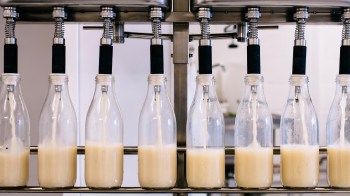Compostable dishes more common at holiday tables
Share Now on:
Compostable dishes more common at holiday tables
Jeremy Hobson: Well at some Thanksgiving dinner tables today, diners will be using disposable plates. And these days, many disposable plates are labeled biodegradable. Sounds pretty good, right? Use it, toss it, and it’ll just turn into dirt.
Well, actually, it’s not that simple — as Marketplace’s Adriene Hill reports.
Adriene Hill: I’m sitting outside in downtown Santa Monica; I have a container of salad here, and this container is compostable. So my post-lunch activity: find out where to compost it.
Here’s the thing, tossing a compostable container in the trash is pretty much like tossing anything else in the trash.
Steve Mojo is the head of the Biodegradable Products Institute, which certifies products as compostable.
Steve Mojo: Those products will behave much in the same way as most things that wind up in a landfill, which is that they are relatively inert, and they’ll be there for a long, long period of time.
Compostable dishes are one of those things that it’s easy to feel good about buying, but won’t make that much of a difference to the environment when you’re finished with them unless they are actually composted. And you can’t throw most of these things in your at-home compost pile. Mojo says some thin products like napkins and bags will break down, but:
Mojo: Thicker parts such as utensils and things like that may be more problematic.
When a container is labeled compostable, it means compostable in a commercial facility — where there’s high heat. So I can’t toss my salad container in the trash. I can’t bring it home. If I want to give myself an environmental pat on the back, I need to find a way to get it to a commercial composter.
I take my trash to the man in Santa Monica who knows best: Wes Thompson, the recycling coordinator in the city.
Hill: So I have in my bag, a lunch container, a compostable lunch container. Where can I take it?
Wes Thompson: Somewhere.
Hill: To you? Could I just bring it to your office?
Thompson: We don’t have containers for public use in places such as Third Street right now.
And that’s the problem with a lot of compostable items these days: in most parts of the country, it’s hard to get them to a composting facility, even as the containers, the dishes, the cutlery and cups become more and more common.
Shomik Majumdar: This market globally has been really growing at a strong and robust growth rate; we see the growth pegged at around 19 percent.
Shomik Majumdar is a vice president at consulting company Frost and Sullivan. He says globally, the market is over $130 million, driven by people’s desire to do right by the environment.
Majumdar: The key drivers that are really boosting this market are obviously the need for eco-friendly products.
Both Majumdar and Mojo point out there is environmental value in some of these products even if they are not composted — they’re often made from renewable resources instead of petroleum-based products. But without commercial composting, these dishes aren’t nearly as good for the environment as they could be.
Back in Santa Monica, recycling guru Wes Thompson tells me the city currently has a pilot composting program for 600 residences. The city also picks up food scraps and compostable packaging from local restaurants. He’s expects the program will expand as demand grows.
I’m Adriene Hill for Marketplace.
There’s a lot happening in the world. Through it all, Marketplace is here for you.
You rely on Marketplace to break down the world’s events and tell you how it affects you in a fact-based, approachable way. We rely on your financial support to keep making that possible.
Your donation today powers the independent journalism that you rely on. For just $5/month, you can help sustain Marketplace so we can keep reporting on the things that matter to you.


















